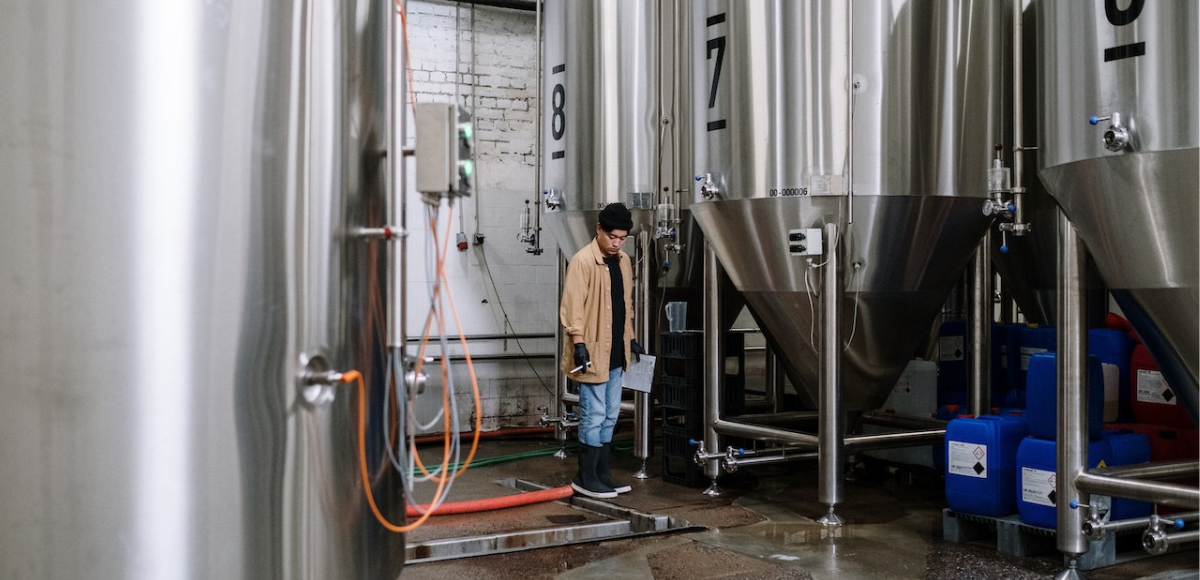Amino acids are the fundamental structural units of protein molecules that determine their biological specificity and nutritional value.
Disruption of amino acid metabolism is the cause of many diseases, which is why in recent years there has been great attention worldwide to studying their properties, methods of production, and potential applications.
Amino acid manufacturing is a complex process that requires advanced technologies, experience, and knowledge of biochemistry for successful implementation.
It holds significant economic potential, making it attractive to entrepreneurs.
What Are Amino Acids?
Amino acids are organic compounds that serve as the fundamental building blocks of proteins, one of the major classes of biomolecules.
They consist of an amino group (-NH2), a carboxyl group (-COOH), and a side chain (R-group) attached to a carbon atom known as the alpha (α-carbon). These components are united into a single molecule. Amino acids are classified based on their properties:
1.) According To The Structure Of The Side Chain
- Aliphatic amino acids contain an aliphatic (hydrocarbon) side chain. This category includes glycine, alanine, valine, leucine, and isoleucine.
- Aromatic amino acids have an aromatic side chain. They include phenylalanine, tyrosine, and tryptophan.
- Ketogenic amino acids can be converted into acetyl-CoA and acetoacetate, which are involved in the synthesis of fatty acids and ketone bodies. These are leucine and lysine.
- Hydroxylated amino acids contain hydroxyl groups (-OH) in their side chains. This category includes serine and threonine.

2.) According To Their Charge
- Sour amino acids can donate protons and have a negative charge at physiological pH. These are aspartate and glutamate.
- Basic amino acids accept protons and have a positive charge at physiological pH. These include arginine, lysine, and histidine.
- Neutral amino acids do not have a significant charge in their side chains at physiological pH. These are serine, threonine, asparagine, and glutamine.
3.) According To Hydrophilicity
- Hydrophilic amino acids contain polar side chains that form hydrogen bonds and interact with water.
- Hydrophobic amino acids contain nonpolar side chains that do not engage in strong interactions with water.
Amino acids are necessary for protein synthesis in the body, which in turn promotes muscle growth and development, bone tissue, skin, and internal organ tissues.
Amino acids play an important role in the formation of enzymes, hormones, antibodies, and participate in many metabolic processes. Some of them are broken down in the body to produce energy.
Humans can obtain amino acids from animal-derived products such as meat, fish, poultry, dairy products, and eggs.
Amino acids are also found in plant-based foods such as beans, soy, peas, nuts, seeds, and grains.
However, not all amino acids are present in certain plant sources. If your diet is not sufficiently balanced, you can use the help of specialized supplements.
They are available in the form of powders, tablets, or liquids. Thanks to private label amino acid manufacturing, you can buy them at any sports nutrition store.
There are amino acids that are available as medicinal preparations. They are strictly prescribed for the treatment of specific conditions, such as certain forms of inherited amino acid metabolism disorders.
Biosynthesis Of Amino Acids
The biosynthesis of amino acids is the process of their formation in living organisms.
Each amino acid has its own unique metabolic pathway and may require various enzymes and intercellular signaling molecules for its synthesis. The following pathways of amino acid biosynthesis exist:
- Aminotransferase pathway.
- Ammonia-glutamate pathway.
- Phosphoenolpyruvate carboxylase-phosphate pathway.
- Ribose-phosphate pathway.
- Shikimic acid pathway.
- Sugar-like amino acid pathway.
The biosynthesis of amino acids plays an important role in providing the organism with necessary biologically active molecules.
However, to ensure proper regulation and progression of reactions, specific enzymes, coenzymes, and cofactors are required.
Enzymes accelerate the rate of reactions by facilitating the conversion of molecules into end products. Cofactors are necessary for enzyme activity.
They participate in chemical reactions, providing catalysis and stabilization of intermediate states.
Coenzymes bind to enzymes and assist in the transfer of chemical groups or electrons in the pathway of amino acid biosynthesis.
Production Of Amino Acids By Microorganisms
Fermentation is the process of organic compound decomposition under the influence of enzymes.
Various fermentation methods are used in amino acid production, and the specific choice depends on the desired quantity of the product, available resources, and economic efficiency.
Batch Fermentation
Is a process in which enzymes are added to the reactor with the substrate once, and then enzymatic reaction takes place.

After reaching a certain level of amino acid, the reactor is cleared, and a new batch of substrate and enzymes is added.
The cycle is repeated until the desired quantity and quality of the product are achieved. Batch fermentation is the simplest method of production.
Fed-batch Fermentation
In this process, enzymes and substrates are initially added to the reactor, and as the reaction continues, new portions are added at specific time intervals. This allows maintaining a constant level of substrate and enzymes, which contributes to increased productivity and higher product yields.
Continuous Fermentation
Is the most complex and advanced method of amino acid manufacturing. The substrate and enzymes are continuously fed into the reactor, and the product exits the system.
The reaction proceeds continuously, and inside the reactor, control is maintained to provide optimal conditions for the growth and activity of microorganisms synthesizing amino acids.
This process ensures high productivity and production efficiency but requires more complex control and regulation of parameters such as temperature, pH, and substrate and enzyme concentrations.
Obtaining Amino Acids By Chemical Synthesis
Obtaining amino acids through chemical synthesis is a process of reaction of organic compounds that involves various reagents and conditions to create the desired molecular structure of the amino acid.
Chemical synthesis and microbial fermentation are two main approaches to amino acid production, each of which has its own advantages and disadvantages. The advantages of chemical synthesis compared to microbial fermentation are as follows:
- High product purity is achieved through process control in the laboratory and optimization for obtaining a specific isomer or amino acid structure. Meanwhile, products from microbial fermentation may contain impurities, other amino acids, microbial metabolites, or unconverted substrates. This requires additional purification steps and can reduce the quality of the product.
- Flexibility in substrate selection for obtaining the desired amino acid, which is particularly useful in creating modified or unnatural amino acids.
- High speed and efficiency of the process when producing on a small scale or using simple amino acids. Microbial fermentation usually requires more time to obtain the desired amino acid, especially when using slow-growing or low-efficiency microorganisms.
The disadvantages of chemical synthesis include:
- High costs for expensive reagents and catalysts, while microbial fermentation can utilize more accessible and inexpensive substrates, reducing production expenses.
- Limited stability. Some amino acids are sensitive to chemical conditions. The result is degradation or the formation of unexpected by-products during synthesis. Microorganisms used in fermentation have the ability to adapt to changes in the environment.
- Limited ecological sustainability. Chemical synthesis can consume a large amount of energy, which has a negative impact on the environment.
From an economic efficiency standpoint, microbial fermentation is considered more attractive due to low substrate costs and a more stable process.
However, chemical synthesis is preferred in cases where high product purity is required.
Sometimes, private label amino acid manufacturing encounters certain issues during production.
They continuously work on solving these problems by implementing new technologies, optimizing processes, and exploring alternative production methods. The main problems include:
- Low product yield, especially when using complex reactions or inefficient methods, increases production costs and reduces overall process efficiency.
- The presence of impurities, by-products, or other impure components lowers the product quality and necessitates additional purification steps. The purification process itself is quite complex and costly, impacting overall economic efficiency.
- The transition from laboratory-scale to commercial production can introduce new challenges. Developing optimal conditions, increasing production volumes, and ensuring process stability on larger scales require additional efforts and resources.
Application Of Amino Acids
Food industry. Amino acids are used as additives to improve the taste, texture, and nutritional value of food products.

Sometimes they are added to cheese, meat products, and fermented beverages as catalysts for fermentation and ripening.
Pharmaceuticals. Amino acids are used as active ingredients in medicinal drugs, formula stabilizers, and for regulating metabolic processes and protein synthesis in the body.
Cosmetics. In the cosmetics industry, amino acids are essential for creating skincare, haircare, and nail care products. They help moisturize, nourish, and strengthen the structure of the skin and hair, promote cell regeneration, and protect against the harmful effects of the environment.
Agriculture. Amino acids enhance the nutritional value of animal feed, contributing to better growth and development of animals, and they also increase the resistance of plants to stress and diseases.
Conclusion
Amino acids are necessary for everyone. They help in muscle mass growth, regulate metabolism, and ensure proper functioning of the digestive and nervous systems.
The production of amino acids is a complex process that has been studied for many years.
Despite the difficulties encountered in production, technological advancements have led to the emergence of more efficient and cost-effective methods.
Barbra Maranda
Latest posts by Barbra Maranda (see all)
- 6 Study Tips For College Students - March 27, 2024
- Benefits Of A Smoke-Free Home - March 13, 2024
- Cyberbullying Affects Teens More Than You Know - March 9, 2024





